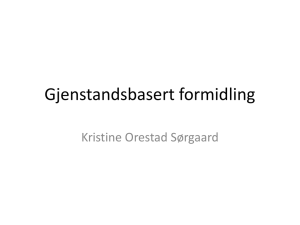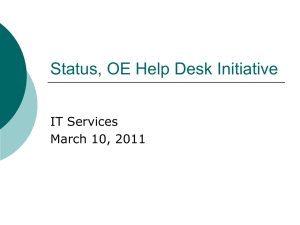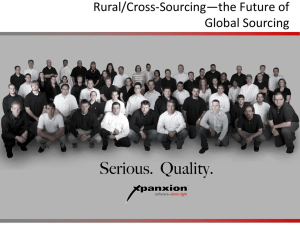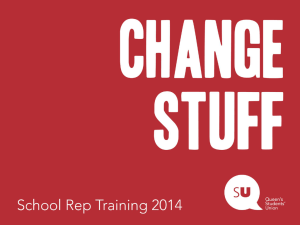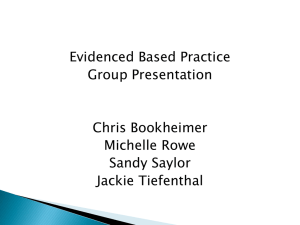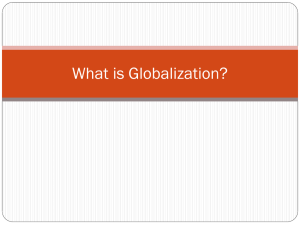Schedule for the AT Kearney Business Unit Strategy Training Program
advertisement
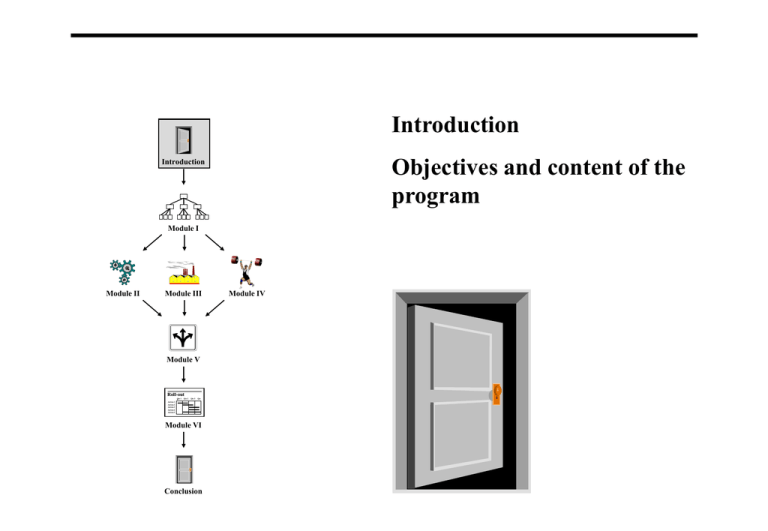
Introduction Objectives and content of the program Introduction Module I Module II Module III Module V Roll-out Qtr 1 4 Qtr 2 Qtr 3 Qtr Action 1 Action 2 Action 3 Action 4 Action 5 Module VI Conclusion Module IV Contents Administrative issues Strategy and its importance for A.T. Kearney Defining strategy and how business unit strategy compares to other types of strategy Objectives of A.T. Kearney’s Business Unit Strategy Training Program Content of A.T. Kearney’s Business Unit Strategy Training Program A.T. KEARNEY BUSINESS UNIT STRATEGY TRAINING Introduction 2 Administrative issues Welcome to the Business Unit Strategy Training Program Help make ATK strategy capable Network with likeminded colleagues Develop skills in strategic analysis Goals of the Business Unit Strategy Training Program Share and test experiences with others Think about business issues from a strategic perspective Source: A.T. Kearney A.T. KEARNEY BUSINESS UNIT STRATEGY TRAINING Introduction 3 Administrative issues About the creation of this program • The program was conceived and developed by the Global Strategy Initiative (GSI), an initiative begun in 1997 to raise A.T. Kearney’s strategy capability. The program is one of several deliverables resulting from the GSI • The program materials were developed by a team of A.T. Kearney consultants from around the world over the course of 9 months • The program was created using a “bottom-up” approach, in which sources from around the firm and academia were gathered and with time filtered into the “finished product” • This is the first version of the business unit training program. It will be updated and improved on a regular basis by a new team of A.T. Kearney consultants Source: A.T. Kearney A.T. KEARNEY BUSINESS UNIT STRATEGY TRAINING Introduction 4 Administrative issues Personal introductions • Name • Office • Experience with A.T. Kearney • Experience before A.T. Kearney • Specific strategy highlights Source: A.T. Kearney A.T. KEARNEY BUSINESS UNIT STRATEGY TRAINING Introduction 5 Administrative issues What is your perspective on strategy, and what are your expectations of the course? • What is your view on business unit strategy in general? • What is your view on A.T. Kearney and business unit strategy? • What are your expectations with regard to this training program? Source: A.T. Kearney A.T. KEARNEY BUSINESS UNIT STRATEGY TRAINING Introduction 6 Administrative issues Schedule for the A.T. Kearney Business Unit Strategy Training Program Time Monday Tuesday Wednesday Thursday Friday Module II Module III Module V Final presentation 8-9 Introduction 9-10 10-11 11-12 12-1 Module I 1-2 Lunch Conclusion Lunch Lunch Lunch 2-3 3-4 Module VI Guest Speaker Module IV Guest Speaker 4-5 Case preparation Case preparation Case preparation Strategy literature review 7-8 Case presentation Case presentation Case presentation Case Dinner preparation 8-9 Dinner Dinner Dinner Dinner 5-6 Lunch 6-7 9-10 10-? Source: A.T. Kearney A.T. KEARNEY BUSINESS UNIT STRATEGY TRAINING Introduction 7 Administrative issues What are our expectations of you? Expectation Source: A.T. Kearney Comments Attentive Give your attention and participate Punctual Be punctual to ensure efficient time management we have a lot of material to cover Curious Ask questions - there are no bad ones Team-oriented Work within teams to reinforce concepts and enhance learning - and give it your full effort Resourceful Draw upon what you have learned in the course and knowledge you have gained through project experiences and other schooling to augment analyses, presentations and group learning Helpful Provide feedback so we can make the course even better A.T. KEARNEY BUSINESS UNIT STRATEGY TRAINING Introduction 8 Contents Administrative issues Strategy and its importance for A.T. Kearney Defining strategy and how business unit strategy compares to other types of strategy Objectives of A.T. Kearney’s Business Unit Strategy Training Program Content of A.T. Kearney’s Business Unit Strategy Training Program A.T. KEARNEY BUSINESS UNIT STRATEGY TRAINING Introduction 9 Strategy and its importance for A.T. Kearney The consulting industry has undergone continuous change during the past two decades 1980-1989 1990-1997 1998 External trends •Globalization of markets •Deregulation •Convergence of industries •Dismantling of conglomerates •Downsizing •Digital world •Virtual companies •Outsourcing •Regionalization (EU, NAFTA, APEC) •Concentration of industries Consultants’ value proposition •Building strategy capabilities •Cost reduction •Organizational design •Industry knowledge/insights •Process facilitators on operations/IT •End-to-end capabilities Key players •McKinsey •BCG •Bain •Booz•Allen & Hamilton •McKinsey •A.T. Kearney •BCG •Bain •Booz•Allen & Hamilton •Big six •McKinsey •A.T. Kearney •Big six (Big four) •International office network •Industry practices •CEO control •Integrated solutions Key factors for •Problem solving capabilities success Note: BCG, Bain, and Booz•Allen & Hamilton are not considered as key players of the future, based on with their present strategy focused offering. Shifts in focus or mergers and acquisitions can make these players more viable competitors in the future Source: A.T. Kearney Introduction A.T. KEARNEY BUSINESS UNIT STRATEGY TRAINING 10 Strategy and its importance for A.T. Kearney A.T. Kearney must improve its strategy capability to become end-to-end capable 5 Strong capabilities 1 Weak capabilities A.T. Kearney’s current value proposition A.T. Kearney’s end-to-end capabilities Strategy Operations 2 5 Information technology 5 Need for improvement on a global basis Source: A.T. Kearney A.T. KEARNEY BUSINESS UNIT STRATEGY TRAINING Introduction 11 Strategy and its importance for A.T. Kearney Introduction to A.T. Kearney’s Strategy Practice Strategy practice mission statement We seek to build the premier capability in developing value and growth strategies for major corporations worldwide and in driving implementation to measurable results We shall broaden our service offerings to include greater perception, ideas, frameworks and methodologies for solving corporate and business unit issues Source: A.T. Kearney We shall broaden our focus to strengthen current account relationships, while building relationships with the leaders of the future We shall achieve the image as a great strategic consulting company based on delivering superior contributions A.T. KEARNEY BUSINESS UNIT STRATEGY TRAINING We shall focus on further developing the growth potential across industries, particularly as it relates to information and technology Introduction 12 Strategy and its importance for A.T. Kearney A.T. Kearney’s value proposition in strategy “A.T. Kearney’s Strategy Practice helps clients turn strategy into action. It sees strategy as the design of the entire business system and an integrated set of actions to continuously create and redefine competitive advantage. This is done through superior customer value with the aim of maximizing shareholder value in the long term” Source: A.T. Kearney A.T. KEARNEY BUSINESS UNIT STRATEGY TRAINING Introduction 13 Contents Administrative issues Strategy and its importance for A.T. Kearney Defining strategy and how business unit strategy compares to other types of strategy Objectives of A.T. Kearney’s Business Unit Strategy Training Program Content of A.T. Kearney’s Business Unit Strategy Training Program A.T. KEARNEY BUSINESS UNIT STRATEGY TRAINING Introduction 14 Defining strategy and how business unit strategy compares to other types of strategy Some strategy definitions Author(s) Definition Sun Tzu • Strategy is the great work of the organization. In situations of life or death, it is the Tao of survival or extinction. Its study cannot be neglected Alfred D. Chandler, Jr. • The determination of the long run goals and objectives of an enterprise, and the adoption of courses of action and the allocation of resources necessary for carrying out these goals Kenichi Ohmae • Strategy is the way in which a corporation endeavors to differentiate itself positively from its competitors, using its relative corporate strengths to better satisfy customer needs James Brian Quinn • Strategy is the pattern or plan that integrates an organization's major goals, policies, and action sequence into a cohesive whole. A well-formulated strategy helps to marshall and allocate an organization’s resources into a unique and viable posture based on its relative internal competencies and shortcomings, anticipated changes in the environment, and contingent moves by intelligent opponents Michael Porter • Strategy is the matching of a company’s strengths and weaknesses to the opportunities and threats in the environment Gerry Johnson & Kevan Scholes • Strategy is the direction and scope of an organization over the long term: ideally, which matches its resources to its changing environment, and in particular its markets, customers or clients so as to meet stakeholder expectations Source: Want, R.L. (1988); A New Translation of Sun Tzu’s Classic “The Art of War”;Chandler, A.D. (1960); Strategy and Structure; Ohmae, K. (1976); Mind of the Strategist; Quinn, J.B. (1988); Strategies for Change; Porter, M.E. (1980); Competitive Strategy; Johnson, G. & Scholes, K. (1993); Exploring Corporate Strategy Introduction A.T. KEARNEY BUSINESS UNIT STRATEGY TRAINING 15 Defining strategy and how business unit strategy compares to other types of strategy A.T. Kearney’s business unit strategy definition enables consultants to carry out an “acid test” as to whether the client has a clear strategy that can enable the company to achieve success A Business Unit Strategy is about ... an integrated set of actions . . . • Does the client manage the value chain in an integrated way? • Does its plan include all of the needed actions? Source: A.T. Kearney to design the entire value system . . . • Is the delivery mechanism in place to meet strategic objectives? • Is the value system effectively structured? to continuously create and redefine competitive advantage . . . through superior customer value . . . with the aim of maximizing shareholder value in the long-term • Is the client's business competition oriented? • Is the client's business customer oriented? • Does the company have a key strategic objective? • Is the competitive advantage sustainable? • Does the customer perceive sufficient value? • Is the company maximizing shareholder value? A.T. KEARNEY BUSINESS UNIT STRATEGY TRAINING Introduction 16 Defining strategy and how business unit strategy compares to other types of strategy The A.T. Kearney definition of BU strategy reflects the importance that the firm places on strategy for the future success of the company an integrated set of actions . . . A program of specified organizational, manufacturing, financial, and managerial actions aimed at integrating all resources of a BU towards a common goal to design the entire value system . . . The sequence of steps and their respective elements (technology, production design, sales, distribution, etc.) by which companies in a given business produce their goods or services and deliver to the customer to continuously create and redefine competitive advantage . . . Competitive advantage is what a company possesses when it earns or has the potential to earn a higher ratio of profit than its competitors. Competition without an advantage for any particular competitor results in a totally competitive market. The market’s forces will not allow any company to realize any returns beyond the cost of equity Competitive advantage needs to be sustainable in a way that competitors cannot copy or nullify the particular advantage through superior customer value . . . The “value” that an end-user receives from the product, which could be economic (low price through cost reduction) or perceived benefit (qualitative) contributed by the product with the aim of maximizing shareholder value in the long-term By maximizing profits, companies maximize shareholder value (the economic value received by owners of equity through dividend payments and/or increases in share price). Shareholder value maximization is widely seen as the appropriate goal of a company and the primary yardstick for measuring performance Source: A.T. Kearney A.T. KEARNEY BUSINESS UNIT STRATEGY TRAINING Introduction 17 Defining strategy and how business unit strategy compares to other types of strategy Although strategy can encompass corporate, business unit and functional strategy, the focus of this training program is on the business unit Industry • Corporate strategy and finance • M&A&D • Design of the corporation and corporate center • Resource allocation • Market and competitive strategies Business unit Corporate • Business unit strategy defines how the company competes within a particular industry or market • Strategies for industry restructuring • Corporate strategy defines the scope of the company in terms of the industries and markets in which its various business units compete Business unit R&D Personnel Finance Production “Where to compete” Source: A.T. Kearney “How to compete” • Functional strategy defines the detailed deployment of resources at the operational level Sales and marketing A.T. KEARNEY BUSINESS UNIT STRATEGY TRAINING Introduction 18 Defining strategy and how business unit strategy compares to other types of strategy What is a strategic business unit (SBU)? Definition of an SBU Some traditional characteristics • A strategically and functionally distinct execution-oriented entity that is usually a subset of a corporation • A unit that has a: – Well-defined market (or market segments) – Well-defined group of competitors – Well-defined business system that serves the market • A unit grouped as such to optimize the collective organizational capabilities among its constituent entities • It is a single business, often with its own P&L responsibilities, or collection of related businesses that can be planned separately from the rest of the corporation/other business units • It has its own competitors, which it is trying to surpass • It has a manager who is responsible for strategic planning, profit, and performance Source: A.T. Kearney; Kotler, P. (1997); Marketing Management A.T. KEARNEY BUSINESS UNIT STRATEGY TRAINING Introduction 19 Defining strategy and how business unit strategy compares to other types of strategy The main elements of a business unit strategy Product/market “Where to compete” In which segments should the company compete? Strategic roadmap “When to compete” Iterative process Capabilities? Action? Critical path Business system “How to compete” ? R&D Design Manuf. S&M Service ? Competitor reaction? At what time and in which sequence should a strategy be executed? Source: A.T. Kearney How should the business system be designed? A.T. KEARNEY BUSINESS UNIT STRATEGY TRAINING Introduction 20 Defining strategy and how business unit strategy compares to other types of strategy Strategy projects differ from other types of engagements in several ways • Unique to each engagement and therefore issue-driven and more flexibly structured • There is not one approach that will work for every situation. However, for every company in every situation, there will be an ideal approach • Broader in scope • More long-term oriented in nature and results might often be intangible for several years • Characterized by ambiguity and a high degree of uncertainty as consultants often don’t know where the project will “end up” • Characterized by many iterations throughout the project due to new findings which can result in changes to the scope and the nature of the project • Characterized by a process and not a single approach Source: A.T. Kearney A.T. KEARNEY BUSINESS UNIT STRATEGY TRAINING Introduction 21 Defining strategy and how business unit strategy compares to other types of strategy Strategy projects differ from other consulting projects in their process approach Mechanical systems thinking Intuition Strategic thinking Problem prototype Process of thought Solution Rearrangement of elements Local optimization, or seeing the tree, not the forest Source: Ohmae, K. (1976); The Mind of the Strategist A.T. KEARNEY BUSINESS UNIT STRATEGY TRAINING Transformation or changed configuration Introduction 22 Contents Administrative issues Strategy and its importance for A.T. Kearney Defining strategy and how business unit strategy compares to other types of strategy Objectives of A.T. Kearney’s Business Unit Strategy Training Program Content of A.T. Kearney’s Business Unit Strategy Training Program A.T. KEARNEY BUSINESS UNIT STRATEGY TRAINING Introduction 23 Objectives of A.T. Kearney’s Business Unit Strategy Training Program The main objectives of the program Company objectives Individual objectives • Strengthen A.T. Kearney’s overall strategy consulting delivery capabilities • Raise A.T. Kearney consultants’ strategy skills to a higher level • Add to portfolio of consulting skills • Offer broader career possibilities within A.T. Kearney • Satisfy intellectual curiosity • Teach A.T. Kearney consultants techniques likely to be applied in many future strategy engagements • Broaden one’s perspective towards consulting engagements • Teach A.T. Kearney’s unique and executionoriented perspective on strategy • Establish a common vocabulary and point-ofdeparture for all A.T. Kearney strategy engagements Source: A.T. Kearney A.T. KEARNEY BUSINESS UNIT STRATEGY TRAINING Introduction 24 Objectives of A.T. Kearney’s Business Unit Strategy Training Program Take-away objectives from the “instruction” and “case” sections of the program The “instruction” section • Understanding of the fundamental strategy analysis techniques The “case” section • Reinforce the concepts taught during the class • Familiarization with strategy concepts that consultants are most likely to apply • Understand when, how, and to what extent to apply the techniques - realizing that use of the analyses will vary with each engagement • Endowment of knowledge that enables consultants to “know where to go,” when asked to use the techniques • Realize that other project-specific strategy techniques are also required in a consulting engagement • Ability to practically apply the knowledge gained from the course in strategy engagements • Understand how to structure a logical and methodical game plan when approaching a strategy project • Be prepared to “hit the ground running” when staffed on an assignment Source: A.T. Kearney A.T. KEARNEY BUSINESS UNIT STRATEGY TRAINING Introduction 25 Objectives of A.T. Kearney’s Business Unit Strategy Training Program The objective of the training program is to teach a set of techniques that form the building blocks of analysis in strategy engagements and not to teach an approach Issue/client objective Framework Solved by Defines Approach Contains Deliverable Shows Technique Shows Example Uses Tool Framework A question which expresses the client’s concern or the uncertainties which must be resolved to achieve the client’s objective. Issue questions are not rhetorical, they should have clear alternative solutions and significant consequences associated with the answer A way of looking at a client’s business issue; a set of building blocks, planks or beliefs that determine at a high level how we might approach a client issue; that ultimately translates to a collection of deliverables Approach A logical structure or sequence of deliverables that might span frameworks. There is no one “approach” to strategy Deliverable A result or insight necessary for the client to reach its objective; that which A.T. Kearney delivers to our client (or to internal clients within A.T. Kearney) as a result of our proposed solutions and engagement efforts Technique A method, model, or calculation that produces a deliverable Tool A spreadsheet, model, database, survey or software used as part of a technique to produce a deliverable Example A specific illustration or application of a deliverable, technique, or tool, generally drawn from a client engagement but sanitized so that the client is unrecognizable Business issue Source: A.T. Kearney, Centres of Excellence A.T. KEARNEY BUSINESS UNIT STRATEGY TRAINING Introduction 26 Objectives of A.T. Kearney’s Business Unit Strategy Training Program This program focuses on teaching techniques because there is not a standard approach to strategy Techniques allow consultants to: • Be flexible in modeling analyses after issues instead of being confined to rigid approaches that may not be relevant in all engagements • Think with a strategic perspective • Adapt skills to other types of consulting engagements Source: A.T. Kearney A.T. KEARNEY BUSINESS UNIT STRATEGY TRAINING Overall strategy frameworks and approaches are not the focus of this program as they vary greatly from client to client and project to project Introduction 27 Objectives of A.T. Kearney’s Business Unit Strategy Training Program The training program focuses intensively on exercises and examples to ensure that the theoretical knowledge can be practically applied Module Example Exercise I Oil and gas services company Big Kahuna Company/ Cessna Aircraft Company II Food and beverage industry Airline industry III Copier company Coca Cola IV n.a. n.a. V Automotive industry Petroleum industry VI n.a. n.a. A.T. KEARNEY BUSINESS UNIT STRATEGY TRAINING Case Motorola Introduction 28 Objectives of A.T. Kearney’s Business Unit Strategy Training Program The techniques taught in this program do not cover all of the areas that might be relevant in strategy projects • The techniques which are taught in the program are the most commonly used techniques in BU strategy engagements • However, some techniques are not described, because they either are covered by other training programs or do not specifically relate to BU strategies Source: A.T. Kearney Change Management (Enterprise Transformation ) Illustrative Finance (CEO Agenda) BU strategy program Purchasing (Strategic Sourcing) A.T. KEARNEY BUSINESS UNIT STRATEGY TRAINING Introduction 29 Objectives of A.T. Kearney’s Business Unit Strategy Training Program This program is complementary to A.T. Kearney’s other major training programs Orientation NCO Engagement execution BUS/ SS Engagement management Business development Account management LSPD Leadership Source: A.T. Kearney CEO: CEO Agenda ET: Revised version of “Transforming the Enterprise” MS: VP- Mind setting program NCO: New Consultant Orientation (including Pyramid and Consultant Process Workshop) SS: Strategic Sourcing Officer Principal Manager Associate MS BA Business process Target audience Business Unit Strategy LSPD: Lead Strategy and Proposal Development ET CEO BUS: A.T. KEARNEY BUSINESS UNIT STRATEGY TRAINING Introduction 30 Objectives of A.T. Kearney’s Business Unit Strategy Training Program This program can be viewed as A.T. Kearney’s “chess book” If A.T. Kearney were a chess club, it would want to establish a set of commonly used, advanced and structured techniques to “play its own game” Source: A.T. Kearney To help clarify these techniques and their use, we are putting them in a “chess book” for the use of all club members A.T. KEARNEY BUSINESS UNIT STRATEGY TRAINING The goal of the chess book is not to develop new or proprietary techniques, but to collect and explain the most commonly used ones to ensure coherent and successful chess playing Introduction 31 Contents Administrative issues Strategy and its importance for A.T. Kearney Defining strategy and how business unit strategy compares to other types of strategy Objectives of A.T. Kearney’s Business Unit Strategy Training Program Content of A.T. Kearney’s Business Unit Strategy Training Program A.T. KEARNEY BUSINESS UNIT STRATEGY TRAINING Introduction 32 Content of A.T. Kearney’s Business Unit Strategy Training Program The structure of the Business Unit Strategy Training Program Module II Structure and dynamics of the industry Module I Identification of the key issues of the engagement Module III Characteristics and dynamics of the individual companies Module V Definition and evaluation of strategic alternatives Module VI Implementable recommendations Roll-out Qtr 1 Qtr 2 Qtr 3 Qtr 4 Action 1 Action 2 Action 3 Action 4 Action 5 Module IV Execution capacity of the client Note: The order of presentation of the curriculum elements should not be interpreted as a sequential guideline for a strategy engagement. Different elements of the program may be referenced at different times in the engagement Introduction A.T. KEARNEY BUSINESS UNIT STRATEGY TRAINING Source: A.T. Kearney 33 Content of A.T. Kearney’s Business Unit Strategy Training Program The content of the program is structured such that related techniques are categorized into deliverables and related deliverables into modules Module: A collection of deliverables that together address a key issue Deliverable: A collection of techniques that address specific issues or sub-issues Technique: A specific analysis performed to test hypotheses * Exercises are located separately in a workbook Source: A.T. Kearney Description: A technique put into context through a definition and/or a description Usage: Why, how, and when the technique is applied Methodology: The process for using the technique Example: A “real-life” presentation of a technique as it would be presented in its completed form Exercise*: A short exercise that requires the participants to employ the technique Conclusion: A summary of key points, strengths, weakness, and references A.T. KEARNEY BUSINESS UNIT STRATEGY TRAINING Introduction 34 Modules I and II: Deliverables and Techniques Module Deliverable Technique I. Identification of the key issues of the engagement • Key issues of the engagement • Issue analysis II. Structure and dynamics of the industry • Industry structure • Players analysis • Strategic group analysis • Substitution analysis • Supply chain analysis • Exit and entry barrier assessment • Development of the industry • Industry strategic era analysis • Life cycle analysis • Trends analysis • Product/market analysis • Size and growth of the market • Product/market segmentation • Demand and supply economics • Demand and supply economics • Industry analysis frameworks • Structure-conduct-performance • The five forces • The strategic triangle Source: A.T. Kearney A.T. KEARNEY BUSINESS UNIT STRATEGY TRAINING Introduction 35 Modules III and IV: Deliverables and Techniques Module III. Characteristics and dynamics of the individual companies Deliverable • Overall company profile Technique • Purpose of the organization • Stakeholder analysis • Strategic era analysis • Strategic planning framework • Product/market focus • Evaluation of product/market segments • Overview of the value chain • Value chain analysis • Cost and margin driver analysis • Financial resources and performance • Development over time • Financial ratios • Company analysis frameworks • 7S • Benchmarking • SWOT IV. Execution capacity of the client • Assessment of execution capacity • Operational capacity assessment • Organizational capacity assessment • Information technology capacity assessment Source: A.T. Kearney A.T. KEARNEY BUSINESS UNIT STRATEGY TRAINING Introduction 36 Modules V and VI: Deliverables and Techniques Module V. Definition and evaluation of strategic alternatives Deliverable • Decision-making Technique • Decision tree • Game theory • Long-term scenarios • Scenario planning • End game • Generic strategy frameworks • Three generic strategies • Gaining strategic advantage • The growth matrix VI. Implementable recommendations Source: A.T. Kearney • Implementable recommendations A.T. KEARNEY BUSINESS UNIT STRATEGY TRAINING • Implementation plans Introduction 37
